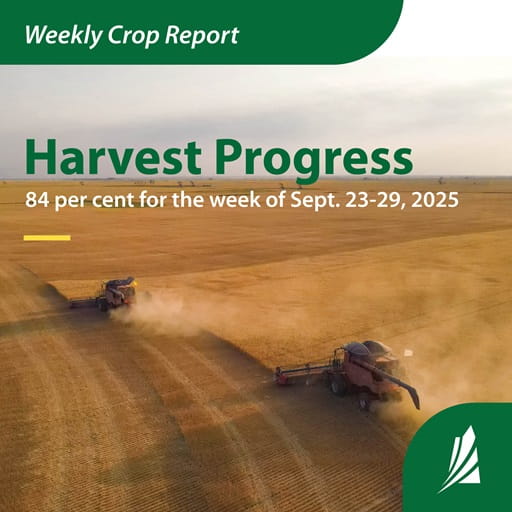Crop Report for the Period September 23 to September 29, 2025
CANADA, October 2 - Released on October 2, 2025
Warm dry conditions across the province helped producers make significant harvest progress this week. Currently, 84 per cent of this year's crop is in the bin, which is a 16 per cent increase from last week. While this is behind our five-year average of 92 per cent, it is slightly ahead of the ten-year average of 81 per cent.
Harvest progress is similar in all regions across the province. The southwest region leads with 87 per cent harvest complete but is closely followed by the west central and northwest areas that are both at 86 per cent harvested. The southeast region is sitting at 84 per cent harvested while the northeast region is at 83 per cent. The east-central region is only slightly behind at 80 per cent harvested.
Harvest is complete for winter wheat, fall rye and triticale, with peas sitting at 99 per cent combined and lentils at 98 per cent. Spring wheat is 92 per cent combined, durum is 91 per cent, oats is 87 per cent, canary seed is 61 per cent and barley is 94 per cent complete. Producers made significant progress on oilseed harvest this past week and canola is now 71 per cent, flax is 45 per cent and mustard is 79 per cent harvested. Chickpeas are at 56 per cent harvested, followed by soybeans at 42 per cent.

Minimal rain was reported across the province this week with the largest amount falling in the Meadow Lake area at 13 millimetres (mm) and 11 mm in the Loon Lake region.
Topsoil moisture conditions fell again this week with a lack of moisture reported across much of the province. Provincially, the cropland topsoil moisture sits at one per cent surplus, 49 per cent adequate, 38 per cent short and 12 per cent very short. Hayland topsoil moisture conditions are at one per cent surplus, 43 per cent adequate, 40 per cent short and 16 per cent very short. Pasture topsoil moisture conditions are one per cent surplus, 34 per cent adequate, 39 per cent short and 26 per cent very short.
When asked about livestock water supplies, three per cent of respondents said there are severe/widespread shortages occurring. Thirty-one per cent reported moderate shortages, 16 per cent said shortages are anticipated and 50 per cent said there are no shortages occurring/anticipated. Provincially 23 per cent of respondents said producers are worried about livestock water quality while the remaining 77 per cent did not have concerns at this time. The bulk of water concerns are related to dry weather, low water levels in dugouts and decreasing water quality.
This week, most of the crop damage was caused by high winds. Some producers reported winds strong enough to blow swaths away. The other reports of crop damage were caused by wildlife and waterfowl.
With an increase in the number of machinery fires being reported, we would like to remind producers to have fire mitigation resources ready, blow off their combines regularly and take precautions when working around powerlines. The public is also reminded to exercise caution when encountering machinery and equipment travelling on roadways.
A complete, printable version of the Crop Report is available online.
-30-
For more information, contact:Legal Disclaimer:
EIN Presswire provides this news content "as is" without warranty of any kind. We do not accept any responsibility or liability for the accuracy, content, images, videos, licenses, completeness, legality, or reliability of the information contained in this article. If you have any complaints or copyright issues related to this article, kindly contact the author above.
